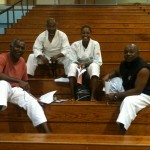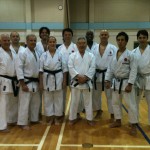Thank you Sensei Mikami and Sensei Kobayashi for an awesome camp!

(6/5/11) DAN TEST and QUALIFICATIONS EXAM
Sensei Kobayashi’s Teachable Point-of View (TPOV) and words of encouragement upon awarding qualification licenses:
Judges-the competitors rely on you for fairness and ensuring their safety
Instructors-keep practicing and improving your skill; your students rely on you and learn from your example.
Examiners-determine the proper rank level for your students; take care of their development and mindful not to “break their spirit”.
(6/4/11) Sensei Mikami credits Sensei Kobayashi for having one of the leading university clubs – being able to preserve the traditional budo of karate as well as successful using modern methods of training. Sensei encouraged us to develop our “best or favorite technique” (TOKUI WAZA). Explore what works for us, develop our strength … and take time to litmus test our technique, benchmark by challenging ourselves at tournaments once in a while. It will certainly be part of our journey and discovery with martial arts.
KATA (Jion and Empi)
Kobayashi Sensei reminds us not to use our lower body to generate power and display large movements – performing a more dynamic form. There are prescribed rhythm to JKA katas and we should strive to follow it – not invent our own. Aspire for precision. In kata, we are our own competitor.
JUDGE’S TEST: Sensei Kobayashi being the General Manager of JKA’s Qualifications Division was truly inspirational here. He demanded a high standard for accuracy, transparency in decision, assuredness and confidence in making calls/decisions and most importantly ensuring the well-being of the competitor – it is the “Spirit of Judging” (responsibility of judges). He asserts that “a competition is good only if there are good judging skills”; “it should be about the competitors”. Sensei took time to critique, correct and explain proper etiquette, gestures, best practices and decision process. “Be decisive – indecision masks the efforts of the competitor”. We all learnt so much – even those of us watching by the side lines.
Afternoon class: KIME
There are 3 elements in executing KIME – (1) Target (2) Speed (3) Concentration. Every move should be delivered with kime.
(6/3/11) Morning class: KIHON/KUMITE
Sensei Mikami started the class with a series of warm-up drills focusing on basic Kihon techniques and discipline. And then he went onto reiterate from yesterday how important “posture” is as well for Kumite (sparring). He reminded that most of us tend to be a little too high on our stances which limits our ability to react or initiate attack. He recommends we keep our ‘center of gravity’ low to the ground for better stability and increased flexibility for varying distance by adjusting shorter or longer stances to reach opponent. Not one hard fast rule in kumite – need more practice to use judgement against many different opponents.

Today, Mikami Sensei reviewed “sweeping” technique with the class. Sensei called out that “getting the opponent to fall to the ground” is NOT THE ONLY REASON to use “sweep”. It is also effective just to “get opponent off balance” thereby creating an opening for a follow-up technique; an effective “feint” to create an opening; or disrupt the opponent’s concentration to create an opening. It is important to practice where to place the sweeping foot – not too high,closer toward the ankle. Also the direction of sweep with hip action will determine effectiveness in execution.
Kobayashi Sensei piled onto the theme, reviewing Kihon – he observed that many of us waste alot of energy during our movement from one stance to another – alot of up and down movement. He reminded us that we should aspire to keep our height constant throughout our movement and preferably “low center of gravity” with good posture. He showed us an exercise how we tuck our legs under us with knees bent and explode to the next stance paying attention not to “hop up and down”. Even when he broke it down for us – not an easy task (though his demo looks effortless), certainly worth investing with practice.

He progressed to 5-step basic sparring citing good kihon techniques as a foundation, and called out that on the defense, a good “counter attack” has to be deliberate and with forward momentum to be convincing. I’m guessing, “not a happenstance, knee-jerk reaction by sticking out a limb with our posture leaning backward just to end the series!” (my pigeon interpretation of his msg delivered in Japanese mind you). To practice the forward momentum counter attack, he modified the 1-step sparring counter to add-on a “kiri-kai” step in oizuki. For example, a jodan punch will respond with an age-uke rising block and quick follow-up by switch legs step forward punch vs the usual reverse punch counter. Pay extra attention to vary your step back according to your opponent in order to execute a strong finish with a step in punch technique. We had many rounds of rotation with varied partners focusing on a deliberate block and fast follow-up (possibly “go-no-sen”). Toward the end, he challenged us to build up speed on the counter, almost blocking in mid-movement focusing on ending with the step in technique “as one motion”. Sorta pre-empting the attack with speed of counter (edging toward “sen-no-sen”). Excellent class! very stimulating, gives fodder to how we can practice these very effective kumite techniques using 5-step and 1-step sparring exercises. A testament to world class JKA instruction!

Afternoon class: KATA (Bassai-Dai and Kanku-Dai)
Kobayashi Sensei was as passionate in Kata instruction. Here are some of his teachable point-of-view (TPOV) on this discipline. Besides good posture and good form (a foundational mandate), there should be “kime” (focus) on every move in the kata – executing with maximum speed, power and finish (almost like katas within the kata). He observed that there is too much use of upper body and upper body strength (making us look very tense and sluggish in our movements) – the key is to utilize lower body and stability of stances to generate power and speed of each move. The upper body will follow and provide the “finish” of the kata. We need to pay close attention when shifting from stance to stance – show the intended weight distribution of each stance in the kata. Of course, all the while keeping good posture with your center axis and a low center of gravity with stances. When first learning a kata, or teaching it – it is like a “textbook kata” just working on the form (kata). But we should aspire to reach for a higher level of performance, injecting “kime” in every move; using all muscles in your body to move with speed and explosion in your transitions; varying the rhythm of the kata emphasizing the slow and fast movements (showing good control), in essence injecting “spirit” in the kata. Your kata should be “ALIVE”! Sensei encourages us to strive for this in all our katas, he called out that Bassai-Dai has 42 moves in all, and Kanku-Dai has 65 moves (the longest kata in our JKA curriculum) lots of stamina, lots of practice … GAMBATTE (keep trying your best!).

(6/2/11) A long day of travel, leaving the home early this morning at 54 degrees and landing in New Orleans at 96 degrees with high humidity. Made it just in the nick of time for 1st class (6pm-8pm) heading straight from the airport in our rental car. Thanks U.N.O. for an air-conditioned gym at the Human Performance Center.

It was great to reunite with friends at this event – where many dojo members come together to train and learn from each other. Also, a wonderful opportunity Sensei Mikami presents to JKA/AF karate-kas to be able to train under the many notable JKA instructors.
Sensei Mikami kicked off the event with a regiment of warm-up drills. Then Sensei Kobayashi reviewed KATA beginning with Heian Nidan. For a tall man, he has beautiful low stances! He emphasized the important of posture and preserving the central axis even when transitioning through moves. He illustrated the point demonstrating on the 1st move of Heian Nidan – how we should begin by bending our knees to get into a back stance keeping our spine straight instead of the tendency to propel our weight and upper body towards our hand technique. He had the class do a partner exercise where we are hip to hip, side by side ‘flanking each other” as we sink to a back stance “joined at the hip”. He also called out the “gyaku-hamni” block to make sure our shoulder position is distinguished by a 45 degree angle in order to deflect oncoming attack (much akin to blocking position in Bassai-Dai just before the first kiai). Then the follow-up “gyaku-zuki” after the kick should be a forward momentum toward the target instead of many who drop into the technique (hi-low).

We also reviewed Heian Sandan and Heian Yondan. He talked about how our head position is critical in setting the stage for good posture – how when misaligned veers our weight off our central axis. Additionally, the importance of using all our muscles in “balance” – a foundation for good posture and stance. For example, the front stance supporting leg has to engage the top of the leg, outside thigh, inside thigh and back of leg equally balanced, else the stance would be skewed. Also the first move of Heian Sandan – do not forget to squeeze your shoulder blades and use the back muscles for power using “expansion and contraction” to exert “explosive” techniques.

Sensei Kobayashi also contrasted Heian Yondan to Heian Nidan first moves as training how to be versatile and control our movements for fast explosive and slow controlled. He reminded us to work on the control movements – paying attention to landing our techniques at the same time, even the slow movements.
Finally, Sensei Mikami invited a few volunteers to demonstrate a few bouts of “kumite” – taking the opportunity to discuss with the class on best practices and distinction of shotokan and JKA techniques – “free feedback and critique”!
Phew, what a first class! I am tired but certainly looking forward for tomorrow bright and early (7am-9am). But first, some Jambalaya at ACME’s as a reward. OSU!
